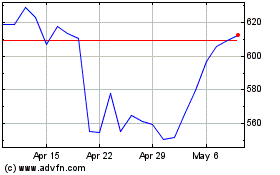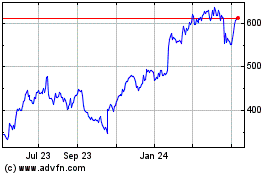AT&T's Revenue Rises as Wireless Unit, HBO Add Customers--2nd Update
April 22 2021 - 11:30AM
Dow Jones News
By Drew FitzGerald
AT&T Inc. piled on more cellphone users, fiber-optic
internet customers and HBO viewers during the first quarter,
showing the media-and-telecom conglomerate's focus on growth as the
economy starts to roar back after a year of coronavirus-related
pressure.
The Dallas company reported 44.2 million domestic HBO and HBO
Max subscribers, up from 41.5 million three months earlier, as its
media division sought to gain on rivals like Netflix Inc. and Walt
Disney Co. That figure included viewers who signed up for the
company's new online streaming video service as well as those with
older subscriptions to HBO through a cable-TV provider.
In the U.S. wireless business, AT&T's core profit engine,
the company added 595,000 postpaid phone subscribers, a highly
valued category of customers who are billed for monthly service
after-the-fact. The carrier also posted a net gain of 207,000
prepaid phone subscribers.
Rival Verizon Communications Inc. on Wednesday reported a net
loss of 178,000 postpaid phone connections over the same period.
T-Mobile is slated to report its first-quarter results next
month.
AT&T executives said the telecom business kept expenses in
check by serving more customers online and by giving its sales
force simpler plans to promote, saving them time. The company also
suggested it would continue offering discounts to attract and keep
customers. That strategy could force competitors to respond in kind
if it is sustained.
"I think we still have room to run," Chief Executive John
Stankey said during a conference call with analysts. "We have seen
our competitors continue to try to compete aggressively. They're
mixing and changing their offers pretty frequently. We seem to be
very consistent and very stable, and that's a really good place for
us to be."
AT&T shares jumped about 5% to $31.66 early Thursday. Shares
have gained 10% so far this year after languishing in 2020.
Overall, net income attributable to AT&T reached $7.55
billion, or $1.04 a share, up from $4.61 billion, or 63 cents a
share, a year earlier. The most recent earnings result benefited
from a large on-paper actuarial gain on the value of its
employee-benefit plans. Total revenue rose 2.7% to $43.9
billion.
The company's reported net debt jumped to about $169 billion,
close to its level two years ago following the Time Warner buyout
that turned AT&T into a media heavyweight. The latest debt
increase stemmed from spending on the Federal Communications
Commission's recent auction of C-band spectrum licenses, a key
resource for wireless companies planning to upgrade their services
to support high-speed fifth-generation, or 5G, network
standards.
Verizon spent the most in the FCC auction, committing $45.5
billion to secure the valuable airwaves. AT&T pledged $23.4
billion for its licenses. Clearing existing users from the spectrum
bands and upgrading network gear will cost the companies billions
of dollars more.
AT&T said Thursday that its debt levels will decline in the
coming years as asset sales and revenue growth whittle down its
obligations. The company also affirmed its commitment to sustaining
its dividend at current levels.
Growth in AT&T's mobile-phone business has picked up in
recent months after the carrier offered new and existing customers
sharply discounted smartphones. The workhorse division has helped
stabilize its parent company's results as its media wing plows
billions of dollars into HBO Max programming. Executives have said
it will take time for the new streaming-video service to turn a
profit, though it also helps wireless profitability by offering
mobile-phone customers another enticement to stay with
AT&T.
WarnerMedia, as the entertainment division is now called, has
also begun to benefit from easier comparisons against last year's
coronavirus-addled results. The media unit's first-quarter revenue
rose 9.8% to $8.53 billion, helped by the return of college
basketball on its cable-TV channels and growing revenue from HBO
Max.
AT&T's consumer broadband division posted a net gain of
46,000 customers, powered by new high-speed fiber-optic lines that
outstripped declines among older copper-based internet
connections.
The unit holding AT&T's DirecTV satellite service ended the
quarter with 620,000 fewer customers, excluding those still using
AT&T TV Now. Cord-cutting has bled companies that sell
traditional channel bundles, forcing many to raise rates, which in
turn prompts more customer defections. AT&T has suffered the
brunt of the trend since it acquired DirecTV in 2015 for about $49
billion.
The company in February agreed to carve out the struggling
pay-TV unit into a separate business jointly owned with
private-equity firm TPG. The complex transaction left AT&T with
a 70% stake in the cash-generating enterprise while ceding legal
control of the business to a stand-alone board. That allowed the
telecom giant to exclude future pay-TV results from its
consolidated financial reports.
Write to Drew FitzGerald at andrew.fitzgerald@wsj.com
(END) Dow Jones Newswires
April 22, 2021 11:15 ET (15:15 GMT)
Copyright (c) 2021 Dow Jones & Company, Inc.
Netflix (NASDAQ:NFLX)
Historical Stock Chart
From Mar 2024 to Apr 2024

Netflix (NASDAQ:NFLX)
Historical Stock Chart
From Apr 2023 to Apr 2024
